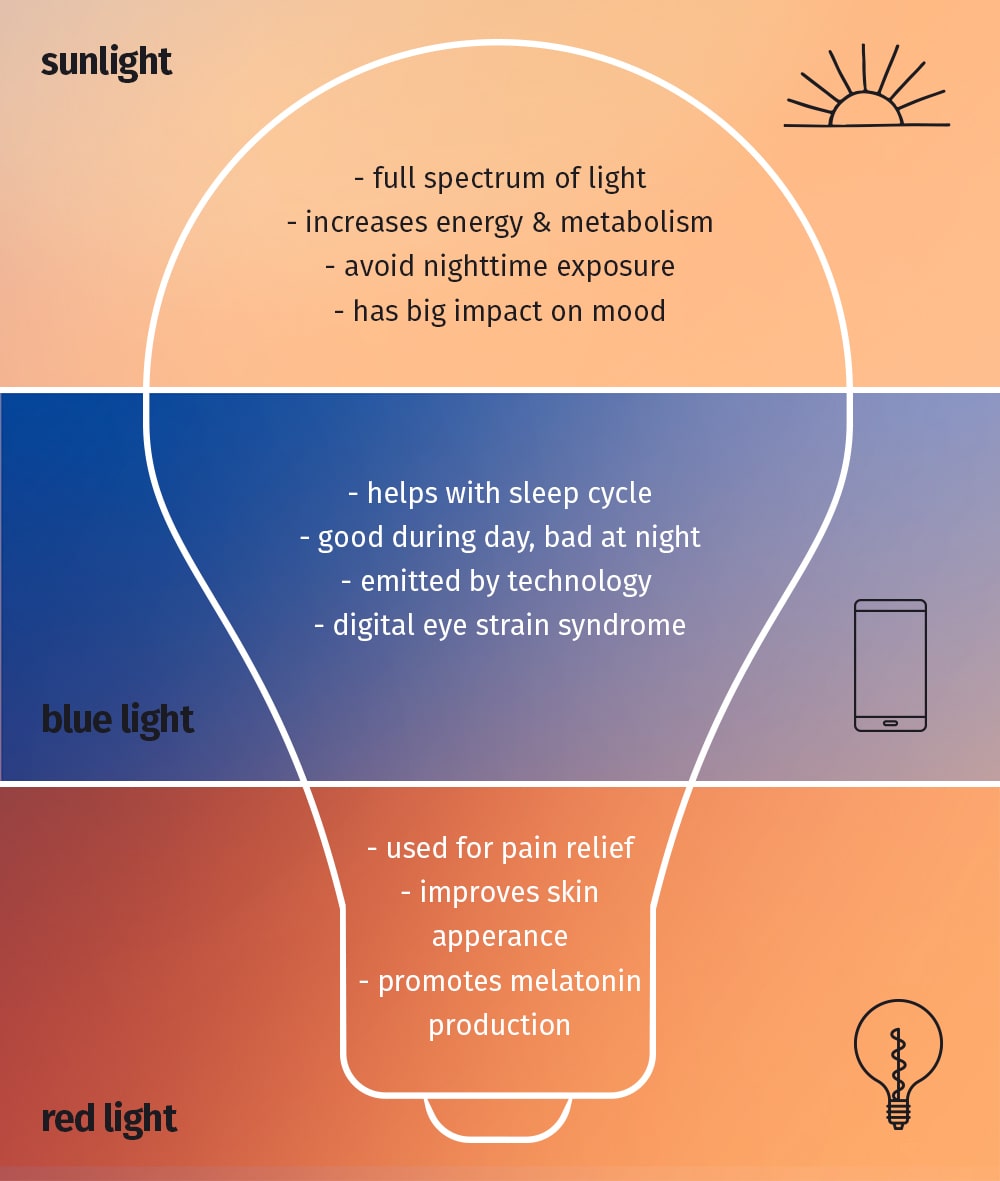These days, we encounter different types of lighting everywhere we go. Fluorescent lights glare at us from the ceilings of offices or train stations; streetlights shine down on us as we navigate urban sidewalks at night; and the light of electronic screens beams at us whenever we look at a laptop, TV, or smartphone. We take all this lighting for granted, but it’s actually a pretty new phenomenon.
Before artificial lighting was invented, people mainly relied on the sun for light. Work was conducted during the brightness of day, and people spent the evenings mostly in darkness—lit only by a few candles or an oil lamp. Human bodies evolved within these natural light-dark cycles. Our circadian rhythms learned to perk up our bodies upon exposure to morning light and wind down during the dark of the evenings.
Without question, artificial lighting has improved our lives in a variety of ways. But exposure to all that artificial light can majorly impact our sleep. And sleep can have a global impact on our health, from anxiety and depression to pain and heart disease.
Light’s effect on sleep often varies depending on the type of light in question. Artificial lights can emit a variety of light wavelengths, including blue, green, red, orange, white, and yellow. Each of these lighting types comes from different sources in our everyday lives, and each of them can affect sleep either positively or negatively.
Eye Cells And Light Exposure
For more than a decade, researchers have known that certain cells in our eyes may play a role in resetting our body’s circadian rhythms when exposed to light. The cells in question “are a type of ganglion cell in the retina that remain sensitive to light, even if you take them out of the eye and put them in a petri dish,” Dr. Gena Glickman, assistant professor of psychiatry and neuroscience at the Uniformed Services University, told Mattress Clarity via email. These light-sensitive cells contain a pigment called melanopsin and are dubbed intrinsically photosensitive ganglion cells—but if that term makes the eyes glaze over, go ahead and call them ipRGCs.
Past studies suggest that ipRGCs boast a couple of unique properties, Glickman says. For example, “They are able to signal continuously under prolonged exposure to light, and… the response can persist long after the light has been extinguished.”
The most recent study to explore how these cells might affect sleep, which was published in the journal Cell Reports and conducted on mice, studied the mechanisms that underlie these distinct properties.
The study’s findings suggest the answer may come down to small proteins dubbed arrestins. “Specifically, β-arrestin 2 promotes the desensitization of active melanopsin, whereas β-arrestin 1 supports receptor regeneration,” Glickman says. These processes help explain ipRGCs’ unique properties during and after light exposure.
Here’s how all of this relates to sleep: “Light via ipRGCs… suppresses the nighttime hormone, melatonin… which may contribute to disturbed sleep,” Glickman says.
Eventually, these findings may help researchers identify potential treatments for circadian rhythm disruptions.
Light Exposure And Sleep
The latest study’s findings help explain why researchers have long observed correlations between prolonged or late-night light exposure and poorer sleep quality. This phenomenon is becoming more common thanks to the ubiquity of light-emitting devices such as tablets and smartphones.
“Light exposure signals time of day to the clock in our brain, and screens emit light,” Glickman says. “In particular, screen usage (and thus, light exposure) in the evening can trick the brain’s clock into thinking it is earlier in the day and make it hard to fall asleep at your desired bedtime.”
In fact, Glickman says, “there have been a number of studies showing strong associations between screen time and later bedtimes/less restful sleep. This is deeply troubling as a poll from the National Sleep Foundation found that the vast majority (89%) of American adults have light-emitting technologies in their rooms at night.”
These negative effects may be of extra concern when it comes to children and adolescents. “[This population is] particularly vulnerable due to having a greater sensitivity to light and being more avid users of smartphones and tablets,” Glickman says.
Luckily, a few simple strategies can reduce the risk of sleep deprivation provoked by nighttime light/screen exposure. There are several steps people can take to regulate their screen exposure and increase their chances of enjoying better sleep.
“The best way to alter screen exposure in order to get better sleep would be to leave your devices out of your bedroom altogether; they are stimulating your brain, independent of the light they emit,” Glickman says. “However, if you must have screens in your bedtime environment, then dim the screen as much as possible and consider installing an app, which changes the spectral (color) quality of the screen in a way that makes it a less potent signal for the various biological effects of light.”
While the new research provides an important understanding of the biological mechanisms that may cause prolonged light exposure to disrupt circadian rhythms, the most important takeaway for the general public is that we would all do well to become more mindful about our screen usage, especially in the hours leading up to bedtime.
In addition, it’s helpful to understand the effects of different light wavelengths on sleep quality, as well as common sources of these wavelengths in our day-to-day lives.
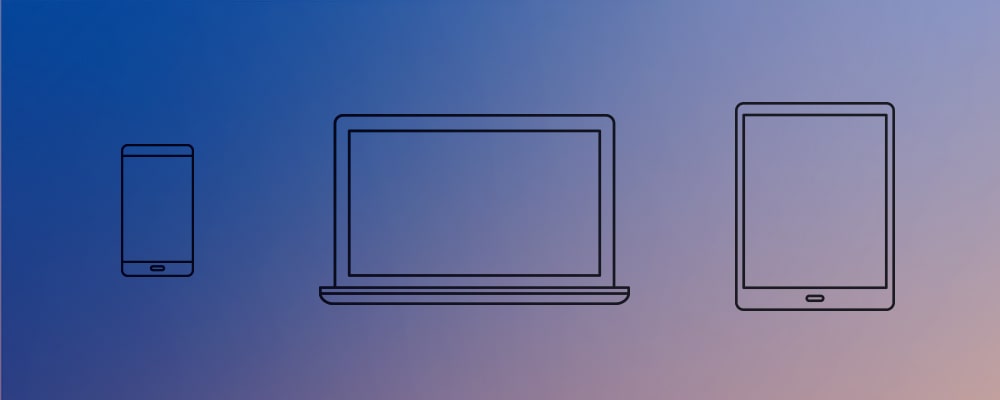
Blue Light and Sleep
Artificial blue light is emitted by blue wavelengths and is found in screen-based electronics as well as energy-efficient lighting. Blue light is also found within white light, which is a mixture of all the visible wavelengths on the color spectrum.
Compared to red light (which we’ll discuss later on), blue light has a higher frequency and carries more energy. That energy spreads to people. Research has found that blue wavelengths have an energizing effect that can boost attention, improve mood, and increase reaction times.
The energizing impacts of blue light can serve us during the day—for instance, when we’re trying to focus on work. But when it’s time to wind down, exposure to blue light can make it harder to fall and stay asleep.
What Sources Emit Blue Light?
Electronics and energy-efficient lighting are the primary sources of artificial blue light. These include:
- TVs. The back-lit screens of televisions emit blue light, which helps explain why most sleep experts discourage keeping a TV in the bedroom. The good news is that TVs tend to emit less blue light than computers or smartphones.
- Computers and tablets. Much like TVs, laptops, desktop computers, and tablets emit blue light from their back-lit screens. Newer computers and tablets may come with built-in features that allow you to adjust the amount of blue light emitted by a device.
- Smartphones. Perhaps the most ubiquitous source of blue light is smartphones. Their small size makes them extra portable, and many of us bring our smartphones into bed with us. This can impair our ability to fall asleep and/or sleep soundly throughout the night.
- CFL and LED lighting. While energy-efficient lighting is beneficial for the environment, it may not be good for our sleep. Compact fluorescent lighting (CFL) and LED lights emit blue light, and exposure to this type of lighting can make it harder to fall asleep.
How Does Blue Light Exposure Impact Sleep?
Blue light’s impact on sleep relates to the energizing effect of its wavelength. Exposure to blue light in the two or three hours leading up to bedtime can:
- Impact circadian rhythms. Research from Harvard found that nighttime exposure to blue light can suppress secretion of the sleep hormone melatonin. Melatonin plays an essential role in regulating our circadian rhythm, or the body’s sleep-wake cycle. When melatonin secretion is suppressed, our body doesn’t initiate the processes necessary for winding down and falling asleep.
- Cause sleep disruptions. Not only can nighttime exposure to blue light make it harder to fall asleep, but it also increases the chances of waking up earlier than you need to and/or waking up during the night. This can negatively impact energy and mood.
- Reduce sleep quality. Research from 2019 suggests that exposure to blue light before bedtime can cause shallow sleep, shorten sleep duration, and reduce sleep quality overall. Not surprisingly, this reduction in sleep quality is linked to morning grogginess.
Provoke aches and pains that impact sleep. Excessive blue light exposure (whether from lighting or electronics) increases the risk of developing digital eye strain, also called computer vision syndrome. This condition involves a range of symptoms including eye discomfort, fatigue, headaches, and neck and shoulder pain. These aches and pains can make it harder to get comfortable after you’ve climbed into bed, which can reduce your chances of falling asleep or sleeping soundly through the night. A mattress for fibromyalgia might help you sleep more comfortably in the face of aches and pains, while minimizing blue light exposure could address the root cause of your discomfort.
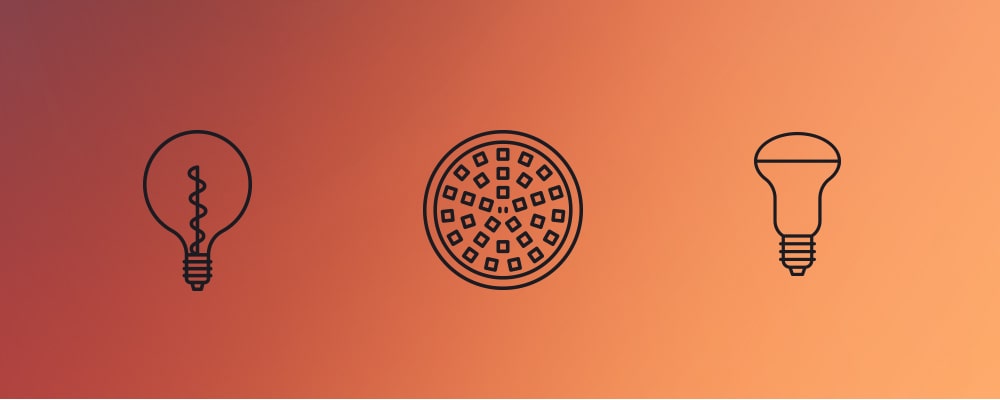
Red Light and Sleep
Compared to blue light, red light has a much lower frequency and does not appear to have an energizing effect. For this reason, red light doesn’t seem to impact circadian rhythms. This means nighttime exposure to red light shouldn’t interfere with sleep. Not only that, but red light may offer a number of health benefits.
What Is Red Light Used For?
Red light therapy (RLT) is an emerging treatment. Per the Cleveland Clinic, RLT may offer a number of benefits including:
- Pain relief. Red light therapy could ease aches and pains brought about by a range of conditions including carpal tunnel syndrome, osteoarthritis, and rheumatoid arthritis.
- Improved skin health. To date, RLT has demonstrated some effectiveness in treating a variety of skin conditions including acne, psoriasis, redness, scars, skin cancer, sunburns, warts, wounds, and wrinkles.
- Soothing the side effects of chemotherapy. There’s some evidence that red light therapy can minimize the side effects of cancer chemotherapy, making treatment more tolerable for cancer patients.
Researchers are still working to understand exactly how red light therapy works, but so far they speculate that red light increases blood circulation, reduces inflammation, and helps the body’s cells work more efficiently so they’re able to repair skin conditions and other issues more quickly.
How Does Red Light Exposure Impact Sleep?
Whereas nighttime blue light exposure can negatively impact sleep, the opposite is true for red light. In fact, red light exposure in the hours leading up to bed could actually support your body’s natural sleep cycle. Here’s a quick look at how red light affects sleep.
- No impact on circadian rhythms. Per Harvard Health, red light is unlikely to suppress the secretion of melatonin. That means it shouldn’t disrupt circadian rhythms—even if you’re exposed to red light in the hours leading up to bedtime.
- Could support melatonin secretion. One small study suggested red light might actually stimulate melatonin production and secretion. While more research is needed, this suggests red light might enable the processes that tell the body it’s time to drift off to sleep.
- Safe to use at night. As noted above, nighttime exposure to red light shouldn’t interfere with your body’s sleep cycles, making it safe to use at night. What’s more, red light is nontoxic, noninvasive, and gentle on the skin.
- Amber-tinted glasses could help people with insomnia symptoms, according to a small 2018 study conducted by the Journal of Psychiatric Research.
The bottom line? When it comes to lighting your bedroom or other spaces where you spend time before bed, red light is a superior choice to blue light.
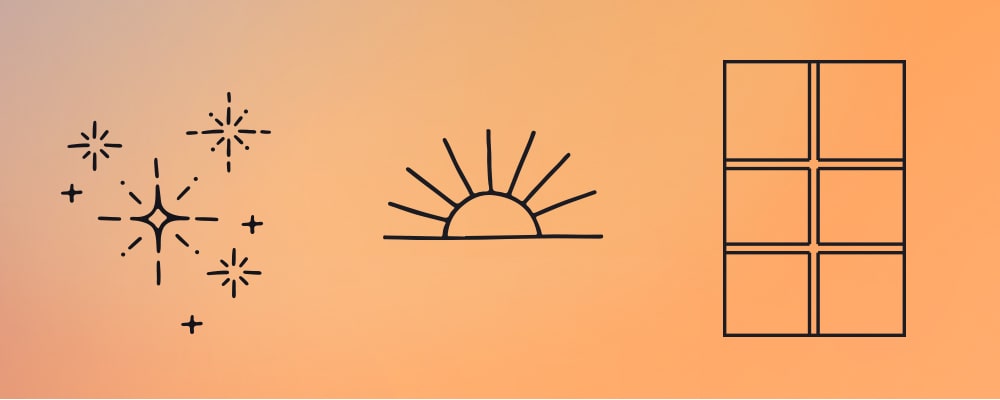
Natural Light and Sleep
As noted above, human bodies have evolved alongside natural light patterns of daylight and darkness. So it should come as no surprise that natural light can have a major impact on our sleep.
In fact, research from 2019 found that exposure to natural daylight can help people fall asleep earlier, sleep longer, and obtain higher-quality sleep compared to people who don’t spend time in natural light.
The trouble is that Americans today spend very little time in sunlight. Data from 2020 suggests Americans spend less than 8% of their time outdoors. This may have serious consequences for our circadian rhythms.
What Is Natural Light?
Before we look at natural light’s impact on sleep, let’s get clear about what natural light is.
Natural light is…
- Full spectrum. Natural light contains all the colors of the rainbow (i.e. colors that are visible to the human eye) as well as wavelengths that cannot be seen by the human eye, such as infrared or ultraviolet.
- Dynamic. The intensity and colors of natural lighting vary depending on the time of day, weather, and physical location in question.
- Linked to human bodies. Natural light has a major impact on the functioning of human bodies, including mood, energy, metabolism, sleep, and recovery. Much of this comes down to the fact that natural light exposure helps regulate hormone production and secretion, and hormones are responsible for a variety of vital functions throughout the body.
In contrast, artificial light…
- Is not full spectrum
- Mimics white light by providing only a few colors of the rainbow
- Does not fluctuate with the time of day, weather, etc.
- Can negatively impact a person’s mood and overall sense of wellness
- Does not support the human body’s natural sleep-wake cycles
What Sources Emit Natural Light?
Natural light is emitted by a variety of sources—both natural and human-made. These include:
- Direct sunlight
- Reflected sunlight, e.g. from a mirror or glass window
- Sun-mimicking lights, which are designed to stimulate natural sunlight. These full-spectrum lights are UV-free, meaning they don’t cause sunburn or increase skin cancer risk. Even so, sun-mimicking should never be used as a person’s main source of natural light. But they can offer an extra boost during cloudy days or to help with seasonal affective disorder (SAD).
How Does Sunlight/Natural Light Exposure Impact Sleep?
Here’s a close look at the many ways that sunlight’s natural patterns of light and darkness can impact sleep-wake cycles.
- Exposure to blue light and/or white light (which contains blue light) during the day can increase alertness and improve mood. This happens naturally when we’re outside during the day. When the sun is overhead, it emits bright, blue, energizing light. This signals to our bodies that it’s time to decrease melatonin levels so we feel more awake.
- By reducing melatonin levels in the morning, our bodies are set up to follow a healthier sleep-wake pattern throughout the day. In fact, research suggests that 30 minutes of morning exposure to natural sunlight significantly increases the chances of getting a good night’s sleep.
- As the sun sets, it emits softer red, yellow, and orange light. These are less energizing than blue and white light and can have a calming effect that supports nighttime restfulness.
- As the sky darkens, this signals to our body that it’s time to produce melatonin, the hormone that helps us feel sleepy.
When these natural patterns get disrupted, so does our sleep. For instance, as noted above, exposure to blue light at night can disrupt circadian rhythms and have a stimulating effect that makes it harder to fall and stay asleep.
In addition to supporting natural sleep-wake cycles, sunlight exposure offers several other benefits that could improve sleep by:
- Increasing one’s Vitamin D storage. This can improve overall wellness by reducing the risk of depression, diabetes, and heart disease. When our bodies and minds feel good, we’re more likely to sleep soundly instead of being kept awake by aches and pains or intrusive thoughts.
- Reducing stress. Soaking up the sun’s rays is associated with reduced stress and improved mood. This can help decrease worrisome thoughts that may keep you up at night.
All told, it’s no surprise that research consistently links natural light exposure with better sleep.
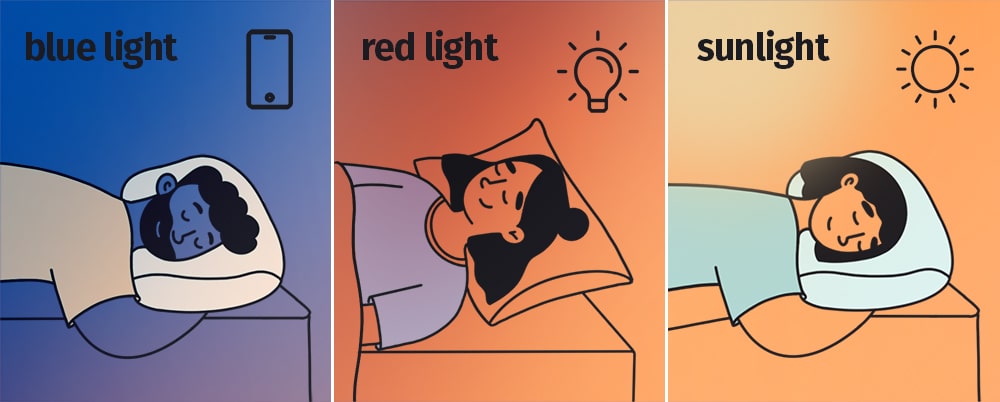
What’s the Best Color of Light for Sleep?
If you’ve read this far, you can probably answer this question on your own! The best color of light for your bedroom (in terms of sleep) is generally anything on the warm end of the color spectrum.
Red, orange, and yellow light are all sound options, because they don’t have an energizing effect and they won’t inhibit melatonin secretion. This allows your body to maintain a healthy circadian rhythm.
That said, the best color of light for sleep sometimes depends on the individual. A 2017 study found that people generally fall asleep most easily when exposed to their preferred color of light. So if you can’t stand red light, for instance, you may fare better with orange or yellow.
Improve Your Sleep with These Lighting Tips
Modifying your daily light exposure can have a profound impact on your sleep. Use these lighting tips to improve your chances of sleeping soundly each night.
- Get outside in the morning. Greeting the sun first thing lets your body know it’s time to kick its sleep-wake cycle into gear. If you’re feeling groggy in the morning, spending time in a brightly lit area can help you wake up.
- Bring natural light indoors during the day. Try opening blinds and curtains, sitting near a sunny window, and using mirrors or reflective paint colors to catch and reflect natural light from windows so it fills the room where you spend the most time during the day.
- Can’t bring daylight inside? Seek it out. If you work in a dimly lit space, try to get outside as much as possible during daylight hours. Take a quick walk during your lunch break, step outside to take phone calls, or exercise outdoors before or after work.
- Cut off screen time two or three hours before bed. Limiting your exposure to screens’ blue light in the hours leading up to bed can seriously improve sleep quality. Switch to a book, a magazine, board games, or other forms of “analog” entertainment for better rest and relaxation. It’s also a good idea to keep all electronics out of the bedroom so you aren’t tempted to use them in bed.
- Use dim incandescent lights at night. Using incandescent bulbs in the evening can decrease your blue light exposure. Install a dimmer switch or use a three-way lamp bulb so you can dim the lights in the hours leading up to bed. This will further reduce blue light exposure.
- Use blackout curtains. Research has found that people who live in densely populated areas (which are lit with bright street lights at night) are more likely to experience trouble sleeping. Even dim light—as little as the light given by 3 candles—can impair sleep. If you live near a source of bright nighttime light, it’s a good idea to invest in blackout curtains. Light still sneaking in? Try pairing blackout curtains with a sleep mask.
- If you work a night shift, enlist the help of tools. If you must use electronic devices at night, wear blue-light filtering glasses and switch your devices to color-shift mode to reduce blue light exposure.
- Try light therapy. If you struggle to access natural light during the day or live in a place where it’s hard to find natural light year-round, consider light therapy. Some research suggests light therapy is as effective as antidepressants when it comes to treating SAD.
Frequently Asked Questions
Does natural light help sleep and mood?
Yes. Natural light has a major impact on the proper functioning of human bodies, including mood and sleep. That’s because natural light exposure helps regulate hormone production and secretion, and hormones are responsible for a variety of vital functions throughout the body.
Do certain lights help you sleep?
Yes. Colors on the warmer end of the spectrum tend to be better options for promoting sleep. Red, orange and yellow light lack the energizing effect of cooler shades, like blue light, which can inhibit melatonin secretion. By minimizing your exposure to blue light before bed, you can help your body maintain a healthy circadian rhythm.
How does light at night affect sleep?
It depends on the wavelength of the light you’re exposed to at night. Warmer colors can help promote melatonin production and maintain a healthy circadian rhythm. Cooler colors, like blue light, can delay that secretion, which makes it harder to fall and stay asleep.
How does blue light affect sleep?
Blue light has an energizing effect. Exposure in the two to three hours before bed can suppress melatonin production, which interferes with the processes required for falling asleep. Blue light exposure before bed also increases the likelihood of sleep disruptions in the night, shorter sleep duration, and reduced sleep quality overall.
Final Thoughts
Lighting can significantly impact your ability to fall and stay asleep, as different types of light have different effects on the body and mind. For this reason, it’s important to modify your lighting exposure to increase your chances of getting restful sleep.
Whenever possible, try to spend some time in natural light early in the day. This will jumpstart your body’s circadian rhythm. Feel free to expose yourself to blue light during the day, as this can increase energy and productivity.
In the hours leading up to bed, it’s critical to limit blue light exposure. Avoid using electronics in the bedroom, and opt for dim incandescent bulbs over fluorescents. Consider using red light instead; it won’t disrupt circadian rhythms and might even support the production of melatonin.
It might take some time to adopt new habits around lighting exposure, but your efforts will pay off in the form of better-quality sleep.
